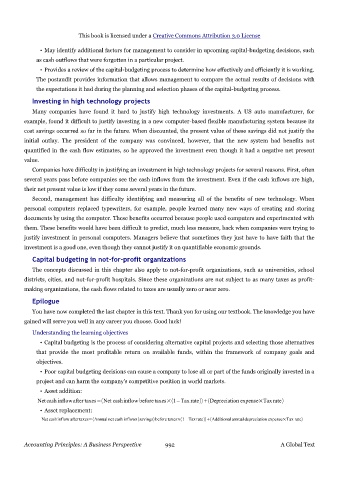Page 991 - Accounting Principles (A Business Perspective)
P. 991
This book is licensed under a Creative Commons Attribution 3.0 License
• May identify additional factors for management to consider in upcoming capital-budgeting decisions, such
as cash outflows that were forgotten in a particular project.
• Provides a review of the capital-budgeting process to determine how effectively and efficiently it is working.
The postaudit provides information that allows management to compare the actual results of decisions with
the expectations it had during the planning and selection phases of the capital-budgeting process.
Investing in high technology projects
Many companies have found it hard to justify high technology investments. A US auto manufacturer, for
example, found it difficult to justify investing in a new computer-based flexible manufacturing system because its
cost savings occurred so far in the future. When discounted, the present value of these savings did not justify the
initial outlay. The president of the company was convinced, however, that the new system had benefits not
quantified in the cash flow estimates, so he approved the investment even though it had a negative net present
value.
Companies have difficulty in justifying an investment in high technology projects for several reasons. First, often
several years pass before companies see the cash inflows from the investment. Even if the cash inflows are high,
their net present value is low if they come several years in the future.
Second, management has difficulty identifying and measuring all of the benefits of new technology. When
personal computers replaced typewriters, for example, people learned many new ways of creating and storing
documents by using the computer. These benefits occurred because people used computers and experimented with
them. These benefits would have been difficult to predict, much less measure, back when companies were trying to
justify investment in personal computers. Managers believe that sometimes they just have to have faith that the
investment is a good one, even though they cannot justify it on quantifiable economic grounds.
Capital budgeting in not-for-profit organizations
The concepts discussed in this chapter also apply to not-for-profit organizations, such as universities, school
districts, cities, and not-for-profit hospitals. Since these organizations are not subject to as many taxes as profit-
making organizations, the cash flows related to taxes are usually zero or near zero.
Epilogue
You have now completed the last chapter in this text. Thank you for using our textbook. The knowledge you have
gained will serve you well in any career you choose. Good luck!
Understanding the learning objectives
• Capital budgeting is the process of considering alternative capital projects and selecting those alternatives
that provide the most profitable return on available funds, within the framework of company goals and
objectives.
• Poor capital budgeting decisions can cause a company to lose all or part of the funds originally invested in a
project and can harm the company's competitive position in world markets.
• Asset addition:
Netcash inflowafter taxes=Net cashinflow before taxes×1 – Tax rateDepreciation expense×Tax rate
• Asset replacement:
Net cashinflow aftertaxes=Annual net cash inflowssavings before taxes×1 – TaxrateAdditionalannual depreciation expense×Tax rate
Accounting Principles: A Business Perspective 992 A Global Text

